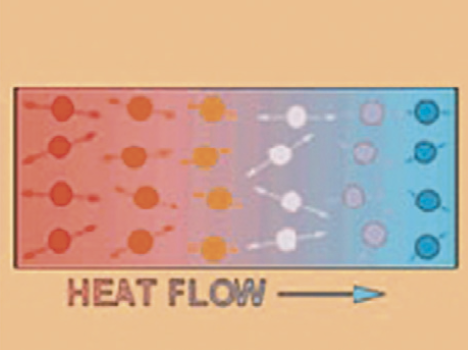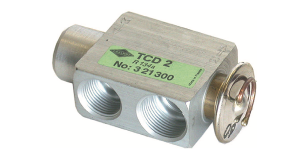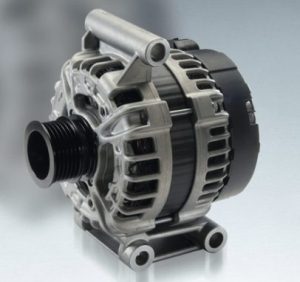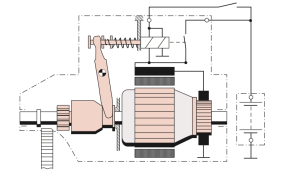Conduction is one of the most fundamental concepts in physics, and it has important implications in many areas of science and engineering. At its core, conduction refers to the transfer of heat or electricity through a material or substance, typically from a region of higher temperature or voltage to one of lower temperature or voltage. While this process may seem simple at first glance, it is actually incredibly complex and has far-reaching consequences for everything from the design of electronics to the study of the Earth’s interior.
In the context of heat transfer, conduction occurs through the motion of atoms and molecules within a material. When a region of a material is heated, the atoms and molecules within that region begin to vibrate more rapidly, colliding with their neighbors and transferring some of their energy to them. This process continues until the entire material is at the same temperature, with the heat spreading out from the hotter region to the cooler ones through the transfer of energy from one atom or molecule to the next.
While conduction is relatively simple to understand in terms of heat transfer, it becomes far more complicated when it comes to the transfer of electricity. In this case, conduction occurs through the movement of electrons within a material, with the electrons flowing from a region of higher voltage to one of lower voltage. The exact mechanism by which this occurs depends on the specific material in question, as different materials have different electrical properties that can influence the way that electrons move through them.
One of the most interesting aspects of conduction is the way that it can be manipulated to achieve specific goals. For example, in the field of electronics, engineers use a variety of materials and structures to control the flow of electrons through a circuit, allowing them to create complex devices that can perform a wide range of functions. Similarly, in the field of materials science, researchers are exploring new ways to enhance the thermal conductivity of materials, potentially leading to more efficient cooling systems and improved energy efficiency in a wide range of applications.
Conduction is also a key concept in the study of the Earth’s interior, as it plays a critical role in the transfer of heat from the planet’s core to its surface. This process, known as mantle convection, is responsible for the movement of tectonic plates and the creation of volcanoes and other geologic features. By studying conduction in the Earth’s mantle, scientists can gain a better understanding of the planet’s structure and history, as well as the processes that drive geological activity.
In conclusion, while conduction may seem like a relatively straightforward concept at first glance, it is actually incredibly complex and has far-reaching implications in many areas of science and engineering. From the transfer of heat within materials to the flow of electrons through circuits, conduction is a critical process that underlies many of the technologies and phenomena that shape our world. As researchers continue to explore the mechanisms of conduction and develop new ways to control and manipulate it, we are likely to see even more exciting developments in fields ranging from electronics to geology.
First, let’s take a closer look at how conduction works in terms of heat transfer. As I mentioned earlier, conduction occurs through the motion of atoms and molecules within a material. Specifically, it occurs when higher-energy particles collide with lower-energy particles, transferring some of their energy to them and causing them to vibrate more rapidly. This process continues until the entire material is at the same temperature, with the heat spreading out from the hotter region to the cooler ones through the transfer of energy from one atom or molecule to the next.
It’s worth noting that different materials have different thermal conductivities, which refers to their ability to transfer heat. Materials with high thermal conductivities, such as metals, are able to transfer heat quickly and efficiently, while materials with low thermal conductivities, such as wood or insulation, are less effective at transferring heat. This is why insulation is often used in buildings to help keep heat inside during the winter and outside during the summer – the low thermal conductivity of the insulation helps to slow down the transfer of heat through the walls and roof.
Now, let’s turn our attention to conduction in the context of electricity. As I mentioned earlier, conduction occurs through the movement of electrons within a material. In order for electrons to flow through a material, there must be a difference in electrical potential between two points – this difference is known as voltage. When there is a voltage difference, electrons will flow from the region of higher voltage to the region of lower voltage, creating an electrical current.
The ease with which electrons can flow through a material depends on its electrical conductivity. Materials with high electrical conductivities, such as metals, allow electrons to flow freely and are therefore good conductors of electricity. Materials with low electrical conductivities, such as plastics or rubber, are poor conductors of electricity and are often used as insulators.
It’s worth noting that not all materials conduct heat and electricity in the same way. Some materials, such as semiconductors, have unique properties that make them useful for specific applications. For example, semiconductors are used extensively in electronics because of their ability to switch between being good conductors and good insulators, making them ideal for creating transistors and other electronic components.
Another interesting aspect of conduction is the way that it can be manipulated to achieve specific goals. For example, in the field of thermoelectricity, researchers are exploring ways to use the temperature gradient between two regions of a material to generate an electrical current. This process, known as the Seebeck effect, has the potential to be used in a variety of applications, such as generating electricity from waste heat in industrial processes.
In summary, conduction is a critical process that underlies many of the technologies and phenomena that shape our world. Whether we’re talking about heat transfer in materials, the flow of electrons through circuits, or the movement of tectonic plates in the Earth’s mantle, conduction plays a central role in our understanding of these processes. As researchers continue to explore the mechanisms of conduction and develop new ways to control and manipulate it, we are likely to see even more exciting developments in fields ranging from electronics to energy production.
Advantages:
- Efficient heat transfer: Conduction is a highly efficient method of heat transfer, particularly in materials with high thermal conductivity. This makes it ideal for applications where heat needs to be transferred quickly and efficiently, such as in cooking or industrial processes.
- Reliable electricity transfer: Conduction is also an efficient method of electricity transfer in materials with high electrical conductivity, such as metals. This makes it ideal for electrical wiring and other applications that require reliable electricity transfer.
- Simple technology: Conduction is a simple technology that does not require complex machinery or equipment, making it easy to implement in a wide range of applications.
- Low maintenance: Since conduction does not rely on moving parts or complex machinery, it is generally low maintenance and has a long service life.
Disadvantages:
- Limited range: Conduction is limited by the range of the material, meaning that heat or electricity can only be transferred through direct contact between the two objects or materials. This can limit its usefulness in certain applications.
- Slow transfer: While conduction is efficient, it is not always the fastest method of heat or electricity transfer. This can be a disadvantage in applications where speed is critical.
- Limited by material properties: Conduction is limited by the thermal and electrical conductivity properties of the material. Materials with low thermal or electrical conductivity will not be effective for heat or electricity transfer.
- Temperature gradients: Conduction relies on a temperature gradient between two objects or materials. If the temperature difference is too small, conduction may not be an effective method of transfer.
In summary, while conduction has many advantages in terms of efficient heat and electricity transfer, it is limited by material properties and temperature gradients, and may not be the fastest method of transfer in all applications. However, its simplicity and reliability make it a valuable technology for a wide range of industries and applications.









